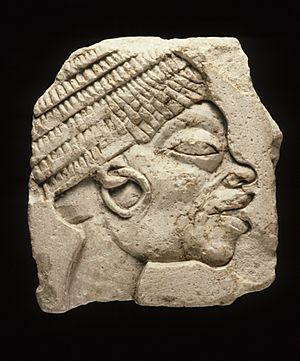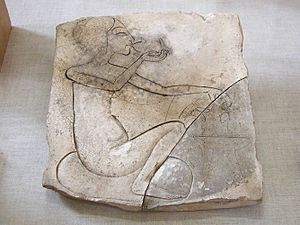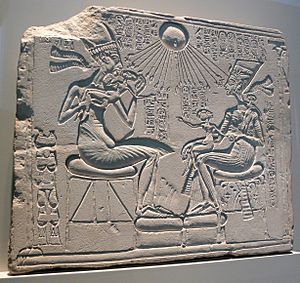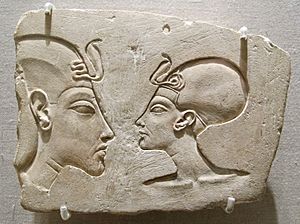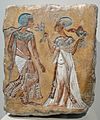Amarna period facts for kids
The Amarna Period was a special time in Egyptian history. It happened during the later part of the Eighteenth Dynasty. During this time, the pharaoh and his queen moved their royal home to a new city. This city was called Akhetaten, which means 'Horizon of the Aten'. Today, we know this place as Amarna.
This period is famous because of Pharaoh Amenhotep IV. He changed his name to Akhenaten (around 1353–1336 BC). He did this to show a big change in Egypt's religion. Before, Egyptians worshipped many gods (this is called polytheism). But Akhenaten wanted people to worship only one main god: the sun disc Aten.
While Aten was the most important god, other gods were still worshipped a little bit. So, it wasn't strictly a religion with only one god (not fully monotheistic). After Akhenaten, his successor, Tutankhamun, brought back the old ways. He made sure all the gods and goddesses were worshipped equally again.
Contents
A New Way to Worship
Akhenaten was one of the first rulers to focus on worshipping mostly one god. This idea of one main god is called monotheism. Experts in Egyptology believe Akhenaten's strong focus on his god, Aten, upset many powerful people. This might have helped end his family's rule. Even though modern experts find Akhenaten's religious changes very important, later Egyptians thought the Amarna period was a difficult time.
During this period, there were many new ideas about religion. Ancient Egyptians saw religion and science as connected. Before, many gods explained things like weather. But in the Amarna period, people started thinking more about how the universe began.
Powerful Royal Women
We know more about the royal women of Amarna than almost any other women from ancient Egypt. They played a very important part in royal and religious life. These women were often shown as powerful leaders themselves.
Queen Nefertiti was believed to be a major reason behind the new religion. Nefertiti's name means "the beautiful one is here." She had six daughters with Amenhotep.
Many of Amenhotep's daughters were also very important. Sometimes they were even more influential than his wives. Amenhotep gave many of his daughters the title of queen.
Amarna Art Style
During Akhenaten's time, royal art changed a lot. Statues of Akhenaten looked very different from typical royal art. Akhenaten was shown in a unique way. He had large thighs, a thin body, a soft belly, full lips, and a long neck and nose.
Some people think this new art style happened because new artists came to Amarna. These artists might have had different training than the sculptors in Karnak.
Tutankhamun and the End of the Dynasty
Tutankhamun died when he was very young, before he was twenty. The last years of his family's rule were not stable. His death meant the end of the royal family line. Two tiny babies found in his tomb might have been his twin daughters. If they had lived, they would have continued the royal family.
The last two pharaohs of the Eighteenth Dynasty were Ay and Horemheb. They were not from the royal family. They were important officials in the royal court. Ay might have married Tutankhamun's widow to gain power. She did not live long after.
Ay's rule was short. His successor was Horemheb, a general in the Egyptian army. Horemheb had been a diplomat for Tutankhamun. Tutankhamun, who had no children, might have chosen Horemheb to rule after him. Horemheb may have even taken the throne from Ay by force. Horemheb also had no children. He chose his own official, Paramessu, to be the next pharaoh. Paramessu became Ramesses I in 1292 BC. He was the first pharaoh of the Nineteenth Dynasty.
Images for kids
-
A relief of a royal couple in the Amarna-period style; figures may be Akhenaten and Nefertiti, Smenkhkare and Meritaten, or Tutankhamen and Ankhesenamun; Egyptian Museum of Berlin.
-
Map of the ancient Near East during the Amarna period, showing the great powers of the period: Egypt (green), Hatti (yellow), the Kassite kingdom of Babylon (purple), Assyria (grey), and Mittani (red). Lighter areas show direct control, darker areas represent spheres of influence. The extent of the Achaean/Mycenaean civilization is shown in orange.
-
Queen Tiye, matriarch of the Amarna Dynasty. She was the mother of Akhenaten and wife of Amenhotep III. She mainly ran Egypt's affairs of state for her son.
-
Akhenaten, born Amenhotep IV, began a religious revolution in which he declared Aten was a supreme god and turned his back on the old traditions. He moved the capital to Akhetaten.
-
Queen Nefertiti, the daughter of Ay, married Akhenaten. Her role in daily life at the court soon extended from Great Royal Wife to that of a co-regent. It is also possible that she may have ruled Egypt in her own right as pharaoh, Neferneferuaten.
-
Maia was the wet nurse of the Crown Prince, Tutankhamun. Having lost his mother at a young age, she helped rear the young prince. Maia was later allowed to have a grand tomb at Saqqara. Here the young prince holds her hand.
-
After the death of Ay, Horemheb assumed the throne. A commoner, he had served as vizier to both Tutankhamun and Ay. Horemheb instigated a policy of damnatio memoriae, against everyone associated with the Amarna period. He was married to Nefertiti's sister, Mutnodjmet, who died in child birth. With no heir, he appointed his own vizier, Paramessu as his successor.
See also
 In Spanish: Periodo amarniense para niños
In Spanish: Periodo amarniense para niños


